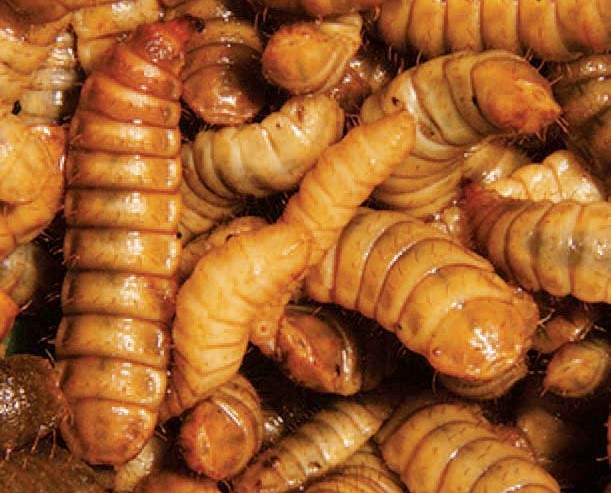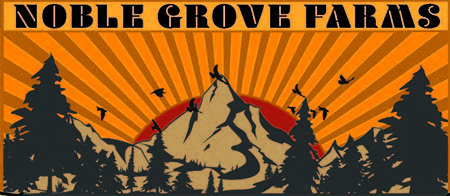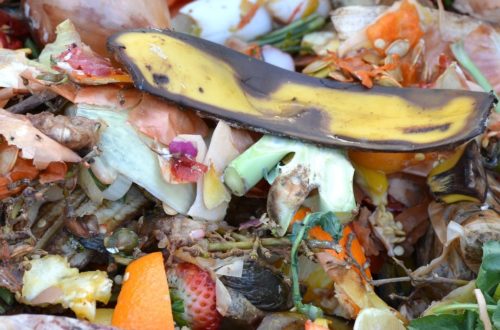I love compost. Specifically, my compost, the product of backyard alchemy. I fuss, fidget, adjust and probably take as much pride in rolling the finished product through my fingers as I do picking the vegetables that grow so healthily in my garden.
So it was with some alarm that I discovered a living intruder, actually a mass of living beasties that had commandeered the top layer of my compost pile. I had recently taken to tossing my kitchen vegetable wastes into my compost bin and connecting the dots, had only myself to blame (or credit?) for the sudden appearance of a mass of brownish beige maggots. Yuck! I recoiled. But instead of immediately eradicating them, I calmed down, researched them on the internet and finally decided that I had been blessed with the larvae of the Black Soldier Fly.
Actually, I found they were quite the amazing little animal. About an inch long, the larval stage is an eating machine. I could tell they loved my old vegetable leftovers and fruit rinds but when I read that they would eat meat scraps, I violated my rule of no animal products in my compost pile and tried an experiment. I scraped together a walnut sized ball of meatloaf fat and pan scrapings and placed it in on top of my compost pile.
At first, not a larva in sight. At the half hour mark, as vigorously as it was moving, the meatloaf looked like it had returned to life. Gasp! A zombie! It had kind of a hypnotic circular motion…
Yes. Where was I?
At the 45 minute mark, the only evidence that there had been violence done was a brown stain where the meatloaf had briefly rested. (CSI take note.)
Well now my brain started firing overtime. Based on the merest suggestion that the black soldier fly would eat almost any animal product, I got to thinking. I have a large fenced yard, ideal for dogs, and occasionally I do dog-sitting to pick up some spare change. I have three cats as well and a small downside to having dogs and cats is the feces that gets left around the yard. Which of course needs to be disposed of quickly and properly. Callously tossing it into the wild area outside the property line is tempting, but the bad kind of flies—bottle, house, etc., the true vectors of disease that I had feared when I first saw the larvae in my pile—still find the dog or cat-doo, lay their eggs there and the new and larger swarm of flies then visit me and mine.
So I set up an experiment. I separated out a large number of BSF larva into a separate bin, filled the bin half full of nearly-done compost to give them a place to rest and hide, stashed small garden trowels here and there for convenience and started tossing in the dog and cat-doo as I came across it in my backyard. And lo and behold, the poop disappeared. And so quickly that the green and bottle flies, if they were there, never had a chance to hatch. At least most of the time it disappeared. I discovered that larvae can quickly turn into inert pupae which in due time hatch into the adult fly. And if a substantial number of the larvae do this at the same time… Well, you then have to go back to flushing the doo down the toilet.
Oh, well. I can live with that.
The black soldier fly (BSF) seems to be found everywhere in North America. They are especially common where flies can get to a wet, rotting food source, garbage or other unsanitary conditions.
The flies start life as eggs that hatch in between four days and three weeks’ time. The hatched eggs spend another two weeks to several months as larvae (also called grubs or maggots.) Larvae go through 5 developmental stages, (instars). This is the only time that the BSF eat.
After they’ve completed their stint as grubs, they hole up in a sort of cocoon called a pupa. The time spent as pupae depends, just like the other stages, on temperature and environment, but if all goes well, adult files free themselves from the pupae and live another five to eight days during which time they breed.
The adults have no mouthparts and cannot bite, but larvae have large and powerful chewing mouthparts with which they shred and devour waste quickly. They are voracious consumers of nitrogen-dominant decaying materials, such as kitchen food scraps and manures.
Oregon State University Extension Service is experimenting with BSF in compost bins.
The larvae are available locally at some farm supply stores.
BSF Fast Facts
Unlike common houseflies,
BSF are not attracted to human
habitation or foods.
• Egg-bearing females are
attracted to rotting food or
manure.
• BSF don’t fly around as much
as houseflies and are very
easy to catch and relocate.
Once inside a house, they do
not avoid being picked up.
• They are sanitary and are not
known to transmit disease.
• They do not bite or sting.







4 Comments
ben
you say in your fast facts that bsf aren’t attracted to human food or habitation yet your article clearly says how they enjoy your waste vegetables. also the bsf that insists on flying around my head right now despite me having a fan on and frequently landing on my arm also says they absolutely ARE attracted to not only humans but also our habitation
Fawad Khan
BSF is a promising insect for bioconversion. Read more:
Tao, X., Xiang, F., Khan, F. Z. A., Yan, Y., Ma, J., Xu, B., & Zhang, Z. (2023). Decomposition and humification process of domestic biodegradable waste by black soldier fly (Hermetia illucens L.) larvae from the perspective of dissolved organic matter. Chemosphere, 317, 137861.
https://www.sciencedirect.com/science/article/abs/pii/S0045653523001273
muhiu anthony
How can i get black soldier fly
Susan Place
I see Black Solder Flys available on Amazon or many feed stores.